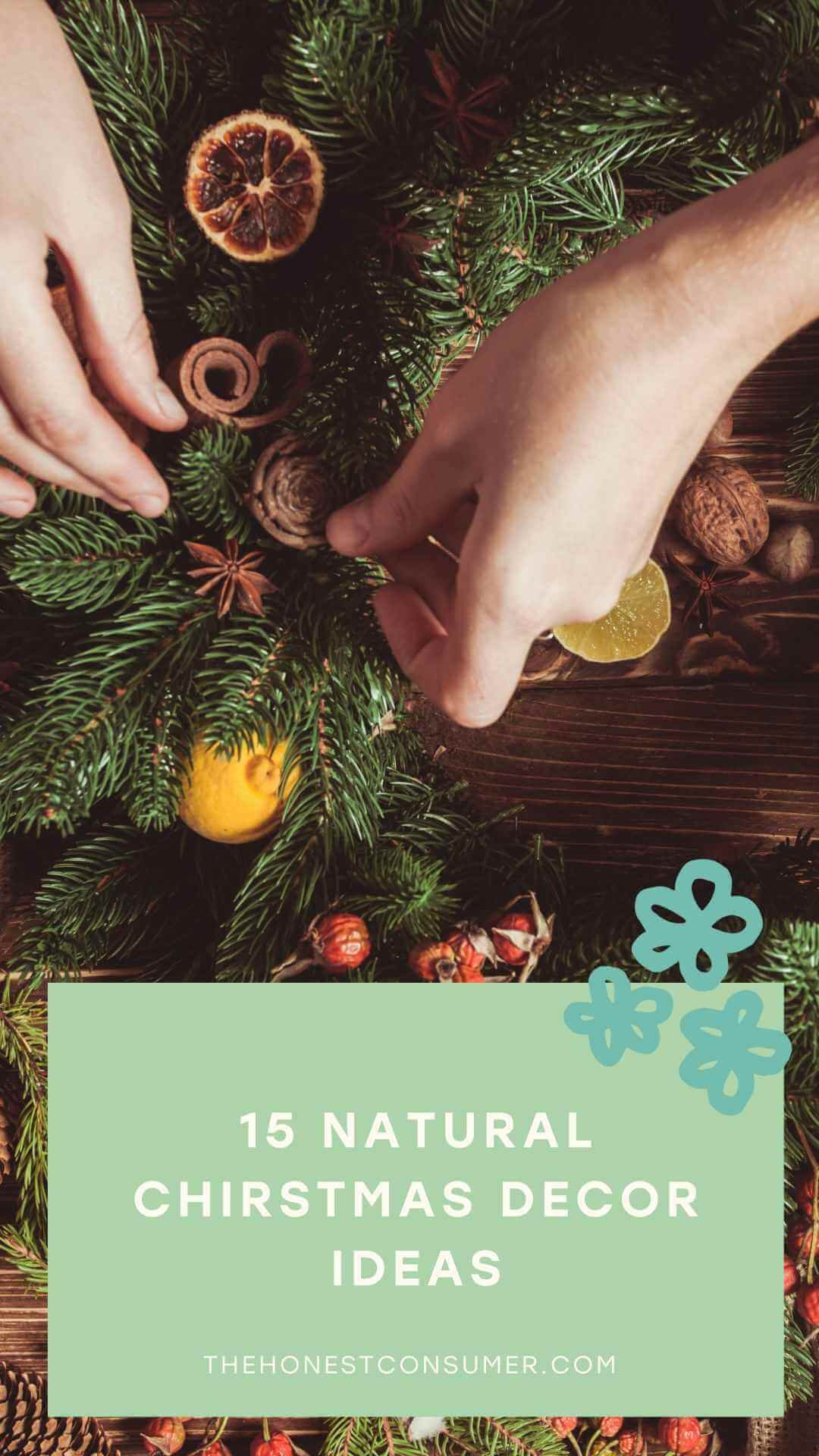15 Natural Christmas Decoration Ideas for Conscious & Greener Homes
Decorating your home for the holidays is a special tradition for the arrival of the festive season. However, the holidays are also a time of increased consumption and waste, and the decorations we use are no exception.
Mass produced Christmas decorations are typically made with plastic and can cause further environmental impact if they are thrown out at the end of the season.
Make your holiday décor more eco-friendly by embracing natural elements and decorating in plastic-free ways. Not only can these materials be better for the environment, but they help reduce waste because so many of them can be disposed of responsibly.
When making décor at home, you can source many natural materials simply by stepping into your backyard or taking a stroll through a park.
Whether buying or making decorations yourself, be mindful of mixed materials and toxic adhesives that may make your decorations unsuitable for compost or recycling bins or will require separation of materials.
A List of 15 Natural Christmas Decor Ideas
Decorating naturally can give your home an authentic, cozy Christmas look and feel and it will make it smell great too. Here are some of the ideas you can try out this festive season.
Evergreen Everywhere
Pine is a classic part of the holidays, and not just because of Christmas trees. Pine can be draped as garlands across furniture and banisters, used as natural frames around mirrors, or add a festive touch to mantelpieces.
They can last for a few weeks, depending on the climate and conditions they’re in, and can be composted afterward. Pine needles can take a long time to break down, so chop up needles before adding them to compost.
Pinecone Bowl
It’s not just the needles that make for great décor. Pine cones can be used in a variety of ways. Make a centerpiece by placing several in a festive bowl or, for a more dramatic touch, add them to a tall glass vase. Get crafty by turning them into natural baubles. Simply loop them with string or ribbon and hang them on your Christmas tree.
As with the needles, chop up cones before adding them to compost. Bear in mind that if they have been spray-painted or bleached you won’t be able to compost them.
Pine is not the only tree bearing needles and cones or used as a Christmas tree: firs and spruces are also popular choices at this time of year.
Festive Flowers & greenery
It doesn’t have to be all about needles and cones. Decorate your home with an abundance of beautiful flowers, plants, and herbs such as Christmas cactus, juniper, eucalyptus, Lenten roses, winter pansies, paperwhite narcissus, rosemary, holly, or poinsettias.
Edible Decor
Why throw out your decorations when you can simply eat them? Tables laden with fruits, nuts, and festive-themed cookies will add color and delicious cheer to a table.
Garlands made from popcorn and cranberries are another Christmas classic.
Dried Fruit Garland
Dried oranges, lemons, and limes add pops of color, are seasonal, and smell great. And they’re so easy to make.
Simply slice up the fruit, place them on baking trays, slip them into the oven on low heat for three to four hours (flipping every hour), and you’re ready to decorate make some natural citrus garland
Traditional Wreaths
Whether you’re using needles, cones, flowers, or fruit (or a combination) they all make great natural materials for wreaths, another classic Christmas item. The wreath’s origins begin in waste management.
When Germans started using evergreens as Christmas trees, they’d trim the tree to make it more uniform or just to fit into the room. Instead of throwing away the trimmings, they used them to create wreaths, whose circular shape is meant to represent eternity since both have no beginning and no end.
Triangle Wreaths
Wreaths don’t need to be round. In fact, the triangular shape of a Christmas tree is meant to represent the Holy Trinity, so you can replicate this with a triangular wreath. This is especially useful if you don’t have space for a tree. You can use twigs and small branches and bind the pieces together with natural twine. Embellish it with evergreen sprigs, dried fruit, flowers, or cones.
Twig Ornaments
Twigs and branches can be used to make many other ornaments too, like stars and snowflakes. String them with ribbon or twine and place them in your Christmas tree.
Salt Dough Ornaments
These salt dough ornaments are also quick and easy to make at home. All you need is salt, flour, and water. Use cookie cutters to create the holiday shapes you want, then pop them in the oven on low heat.
While they’re in the oven, make natural dyes for the ornaments by mixing turmeric, cocoa, crushed mint leaves, or beetroot powder with a little water. Alternatively, you can press herbs or flowers into the dough before baking them. At the end of the season, they can be added to compost.
Candles
Candles are a big part of Christmas. Keep them natural by looking for those made out of materials like soy or beeswax. Make sure they are 100% natural and not mixed with synthetic wax. Spruce them up by wrapping them with a ribbon and adding a sprig of holly.
Paper Decorations
Grab paper and scissors and release your inner crafty kid. Cut out snowflakes for windows, fold angels for trees, or level it up by making paper pinecones and Christmas trees. These decorations can be recycled or composted later, provided the paper is not colored with synthetic dyes or covered in plastic coating.
Fabric Décor
From Christmas trees and stockings to baubles, bells, and stars, with a couple swatches of fabric, a needle, and thread, there are a lot of decorations you can make. It can be as quick as crocheting a few stars or take a bit more time and effort with something like a stuffed bauble or bell.
If you add embellishments like buttons and beads, use what you have in your craft box or check out thrift stores for these items.
In order to be compostable, all the materials – from the fabric (and its dye) to the thread and stuffing – need to be made from natural materials like cotton, hemp, or wool. If embellishments are synthetic, these need to be removed first. However, with a good pattern and a deft hand, you can make beautiful holiday ornaments that will last years.
Mistletoe
What’s Christmas without a kiss beneath the mistletoe? This is another classic and can be composted. As with needles and cones, cut up the plant before adding it to compost and ensure you remove the seeds, so it doesn’t start growing in your compost or garden.
Mistletoes are a parasite and can stunt the growth of trees and shrubs. Alternatively, make mistletoe out of paper or fabric.
Driftwood
If you’re by the sea, or next to a river or lake, driftwood is a great way to bring your surroundings into the festivities. There are a multitude of ways you can make them holiday-appropriate. Wrap them in fairy lights or place them in a vase and decorate them with your other DIY decorations.
Shells and Sea Glass
Shells come in many different colors and sizes and can also add beachy holiday cheer to your home – just be sure to clean them properly.
Starfish and sand dollars may seem like the perfect addition to Christmas at the beach, but you should never remove them when alive. If you’re uncertain, rather leave them alone. Instead, pick up sea glass, which comes in a variety of colors and helps clean up the beach.
Triangle Wreaths
Wreaths don’t need to be round. In fact, the triangular shape of a Christmas tree is meant to represent the Holy Trinity, so you can replicate this with a triangular wreath. This is especially useful if you don’t have space for a tree.
You can use twigs and small branches and bind the pieces together with natural twine. Embellish it with evergreen sprigs, dried fruit, flowers, or cones.
A few other Christmas posts for Conscious Consumers
MEET THE AUTHOR
Claudia Hauter is a South African writer, copy editor, and content creator with degrees in Drama and Anthropology. She works in television managing web content. When she isn’t reading or writing, she’s walking her dog, finding small businesses and markets to support, or attracting butterflies and bees with her vegetable garden. Learn from Claudia on Twitter or Instagram.
For more ethical & sustainable tips be sure to explore more conscious lifestyle blog posts, follow The Honest Consumer on social media, subscribe to our newsletter, & check out the Ethical & Sustainable Brand Directory.







